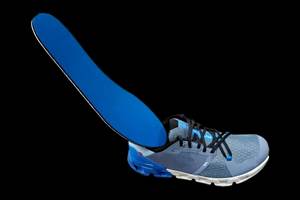Composites comfort wheelchair travelers
Long carbon fiber thermoplastics replace aluminum in more forgiving front casters.
Disabled people who require wheelchairs for mobility typically feel every bump in the road. As their chairs encounter obstacles others might consider insignificant — cracks and uneven surfaces — they experience jolts that can cause fatigue and, for some riders, cause pain that requires medication. The rough ride, according to Frog Legs Inc. (Ottumwa, IA, US), is traceable primarily to the wheelchair’s front casters.
Founded in 1997 by Mark Chelgren, the company started up after a chance encounter with a quadriplegic rugby team. A discussion about their wheelchairs led Chelgren to develop an alternative to the rigid casters used for the wheelchairs’ front wheels. Instead of fixed forks that require the wheel to move up and over obstructions — bouncing the rider in the process — Chelgren designed his forks with a patented pivot point and wedge-shaped shock absorber, fashioned from aluminum, that allows them to move smoothly over impediments in an arc path, functioning much like airplane landing gear.
In 2016, Chelgren felt he and Frog Legs could produce a better product by switching from machined aluminum to an even lighter alternative. “We are always being pushed to lighten our products. People with disabilities are greatly affected by any additional weight.” That effort led them to carbon fiber composites and to PlastiComp Inc. (Winona, MN, US), a supplier of long fiber-reinforced thermoplastics and technologies. PlastiComp provided not only the material, but also assistance to ensure the material change would be successful.
“We looked at a different type of manufacturing process than machining. Injection molding allowed us to have a much more complex shape, and carbon fiber composites really gave us advantages in what our design parameters could be,” relates Chelgren. Rather than settle for “black aluminum,” a new fork design was created, one that would be almost impossible to machine or forge in metal, he adds. Toward that end, Frog Legs took advantage of PlastiComp’s application design and performance analysis services throughout its product development cycle. “In my opinion, PlastiComp became our partner in making a better product,” says Chelgren. “It was a collaborative process — we weren’t going it alone.”
The second-generation caster wheels make use of two PlastiComp long carbon fiber-reinforced composite materials. A long carbon fiber-reinforced nylon 6/6 composite is used in the wheel forks, and a long carbon fiber-reinforced thermoplastic polyurethane makes up the wheel hub. PlastiComp developed the reinforced polyurethane to enable it to chemically bond with the urethane used for the outer rolling surface of the wheel. Says Chelgren, “With an aluminum hub, the dissimilar materials never fully bond and can slip.”
Six months of development were followed by a few months of testing. During that time, the new design passed RESNA (Rehabilitation Engineering Society of North America, Arlington, VA, US) industry standard tests, which subjected the casters to severe impact and drop forces. The resulting pair of Frog Legs casters made from PlastiComp materials weigh 33% (280g) less than the legacy aluminum casters. And, the new product can decrease vibration not only in wheelchairs but also in any type of caster-equipped rolling equipment, concludes Chelgren.
Related Content
Pull-wound carbon fiber poles enable lightweight, compact, rigid emergency stretcher
Based on military feedback, Epsilon Composite developed an optimized, foldable stretcher that combines telescopic pull-wound carbon fiber tubes.
Read MoreUrban furniture project demonstrates green potential for composite 3D printing and recycled materials
Large-format AM specialist Caracol and partners designed custom, 3D-printed outdoor furniture with glass fiber-reinforced recycled polypropylene, and conducted an LCA to evaluate and improve the process.
Read MoreComposite materials, design enable challenging Corvette exterior components
General Motors and partners Premix-Hadlock and Albar cite creative engineering and a move toward pigmented sheet molding compound (SMC) to produce cosmetic components that met strict thermal requirements.
Read MoreRunning shoe insoles get a lift with thermoplastic fiberglass tapes
FlexSpring insoles take advantage of unidirectional, continuous fiberglass and thermoplastics to enable next-level performance for the everyday runner.
Read MoreRead Next
Plant tour: Daher Shap’in TechCenter and composites production plant, Saint-Aignan-de-Grandlieu, France
Co-located R&D and production advance OOA thermosets, thermoplastics, welding, recycling and digital technologies for faster processing and certification of lighter, more sustainable composites.
Read More“Structured air” TPS safeguards composite structures
Powered by an 85% air/15% pure polyimide aerogel, Blueshift’s novel material system protects structures during transient thermal events from -200°C to beyond 2400°C for rockets, battery boxes and more.
Read MoreDeveloping bonded composite repair for ships, offshore units
Bureau Veritas and industry partners issue guidelines and pave the way for certification via StrengthBond Offshore project.
Read More























